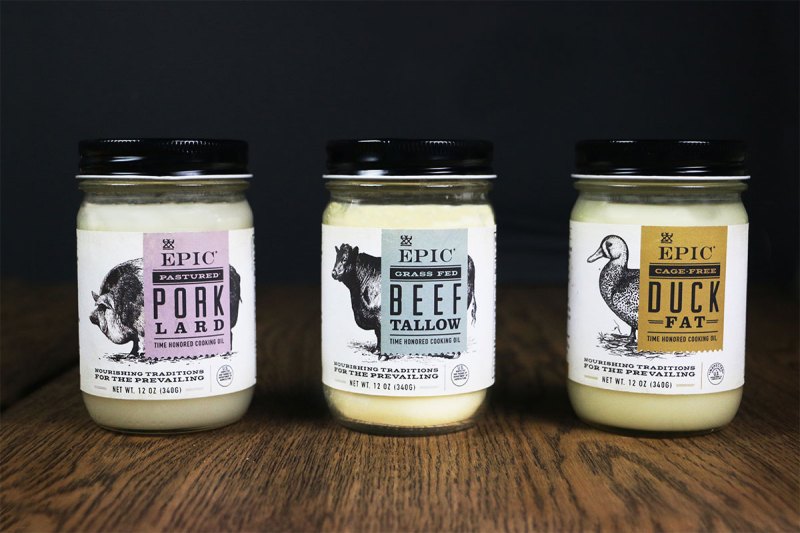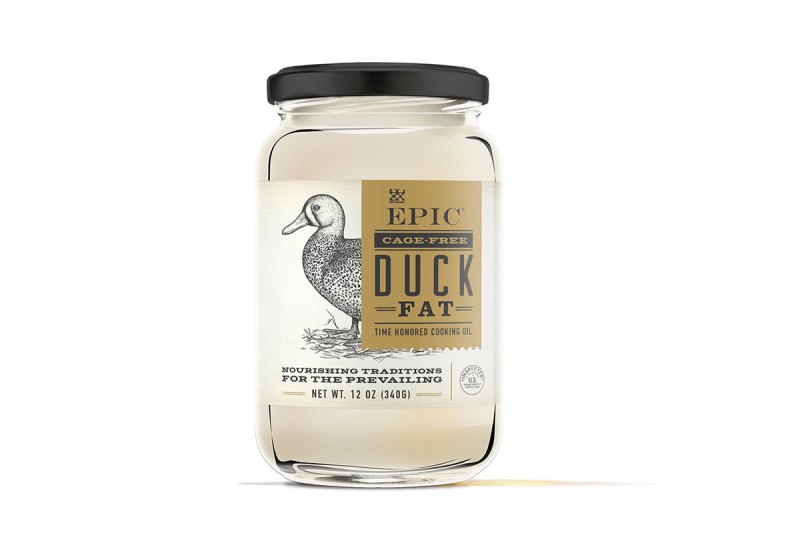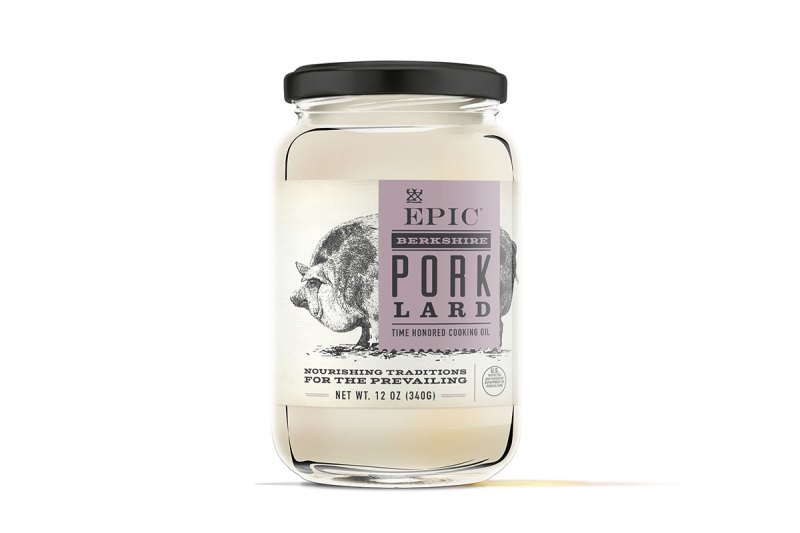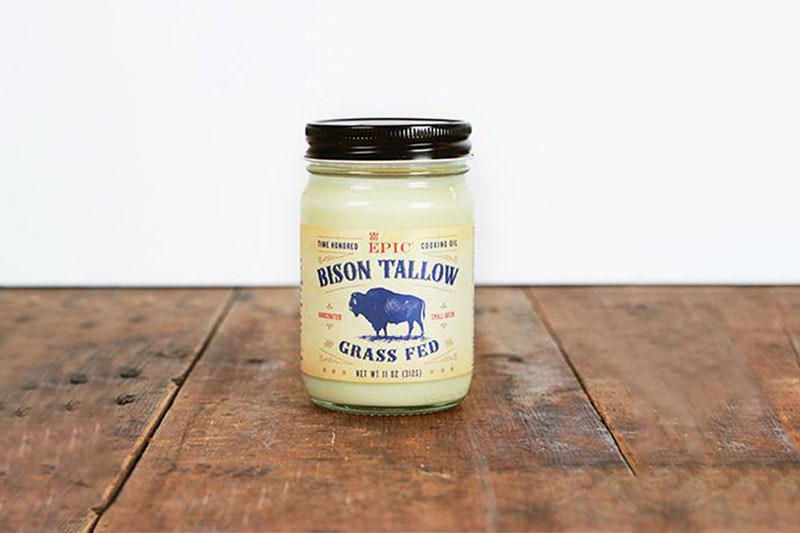
Before this tasteless war, we used animal fats to cook, but then nutritionists decided fat was bad, especially saturated fat. It was goodbye lard, goodbye tallow, hello, canola oil. In the 1990s, even famed chef Julia Child lamented the fact that McDonald’s stopped using beef tallow to fry their French Fries. Science now suggests fats aren’t the devil and EPIC Provisions is helping to usher these happier, more delicious times back in with animal cooking oils from grass-fed, ethically raised ducks, pigs, bison, and cows.
If you longingly remember your grandmother’s cooking, it’s probably because she used animal oils for cooking and frying. Humans have a long history of using tallow to cook, clean, and make candles. Lard is what makes pie crusts worth eating and takes fries and fried chicken to divine levels. Duck fat could make a tire taste good.

Sure, you’re thinking, because it’s bad for you and full of fat and fat will make my heart stop and I need a heart to live. Fortunately, more and more studies show that’s not the case. Take a moment to rejoice and then let’s reintroduce you to your favorite new cooking essentials so you’re ready to dive into the recipes below:
Tallow, the rendered fat of a cow (and/or, in EPIC’s case, bison), is a wildly stable oil that’s perfect for cooking with or at high temperatures. Tallow gives you no fear of smoking oil, like you get from things like olive or canola oils. It’s something you can use with veggies, or even scramble your morning eggs in it. The rich smell and flavor make your house smell cozy and happy instead of the acrid, lingering scent of scorched canola oil. It adds a depth of flavor vegetable oils just can’t touch.

Same with lard, the rendered fat from pigs that makes life worth living. It’s essentially a butter substitute, so grill your steak in it, bake with it, hell, even feel free to put a bit on top of your baked potato.
If you’ve been to a restaurant lately, it’s likely you had some duck fat fries. They are trendy for a reason: they’re absurdly delicious; the duck fat adding a subtle but powerful flavor that will have you considering eating it with a spoon from the jar. EPIC’s ducks are cage-free ducks who roam, quack, waddle, do everything wild ducks do.
Another benefit of using animal fats is actually benefiting the animals themselves: Using animal oils creates the need for a whole-animal philosophy, reducing needless waste.

So, now that you’re a reformed fat eater, you need to find the best, most ethically sourced animal oils. You can make these fats yourself, but buying from EPIC Provisions does a lot more than just make your food healthier and tastier: they’re helping the environment. The Austin, Texas-based company works with The Savory Institute to ensure the animals used in their products are grass-fed and pasture grazed, using something called the Holistic Grazing Approach. Long story short, we need large herds of animals chewing, stomping, and defecating to keep grasslands healthy. Turns out, this natural grazing pattern also helps trap CO2 in the ground, reduces soil erosion and mineral depletion, which can lead to vegetables not being as nutritious. Additionally, grass-fed cows (vs corn-fed) are healthier to eat, higher in Omega-3s, Vitamin E, and lower in saturated fat. They also require fewer antibiotics because they’re not slowly dying from an unnatural corn diet. There’s a lot more information about all of this here (and some cool videos) if you want to learn more.

Using EPIC Provisions’ animal cooking oils means you’re eating healthier, more delicious food that provided a chance a happy life for animals while actively saving the environment. Hungry yet?
Below is one of our favorite EPIC Provisions recipes, but they have tons more for each oil.
Bison Tallow Skillet Shepherd’s Pie
Ingredients:
- 3 large russet potatoes, scrubbed and cubed
- 2-3 tablespoons EPIC’s Bison Tallow, melted and divided
- ½ cup unsweetened almond milk
- 3 tablespoon fresh parsley, chopped
- 1 lb. ground bison
- 1 yellow onion, chopped
- 3 medium carrots, sliced
- 3 stalks of celery, sliced
- ½ lb crimini mushrooms, sliced
- 1 tablespoon fresh thyme leaves (or 1 tsp. Dried thyme)
- Sea salt and pepper to taste
Preheat oven for 400F. Bring a quart of water to a boil in a large stock pot. Boil chopped potatoes until tender- about 5 to 7 minutes. Strain hot water from potatoes and return to pot. Add 1 TB. of the bison tallow and the almond milk. Using a potato masher, mash until smooth and well mixed. Season with chopped parsley, sea salt and black pepper to taste. Set aside.
In a large cast iron skillet, brown the ground bison over medium-high/high until just cooked. Stir often, ensuring that the bison does not stick to the bottom of the skillet. Set the cooked bison aside on a plate reserving any juice. Over medium high heat, add the remaining 1 to 2 TB of bison tallow to the cast iron skillet. Sauté the onion, carrot and celery for 2 to 3 minutes. Stir in the mushrooms and thyme and sauté for another 3 to 4 minutes or until softened.
Remove the skillet from heat and stir in the cooked bison. Season with sea salt and black pepper to taste. Spread the mixture evenly through the skillet and spread the mashed potatoes evenly on top. Smooth the mashed potatoes with the back of a spoon.
Bake in the oven for 15 to 25 minutes or until the top is lightly browned and the mixture is beginning to boil around the edges. Rest for 5 minutes before serving with a large spoon.
Salud!


